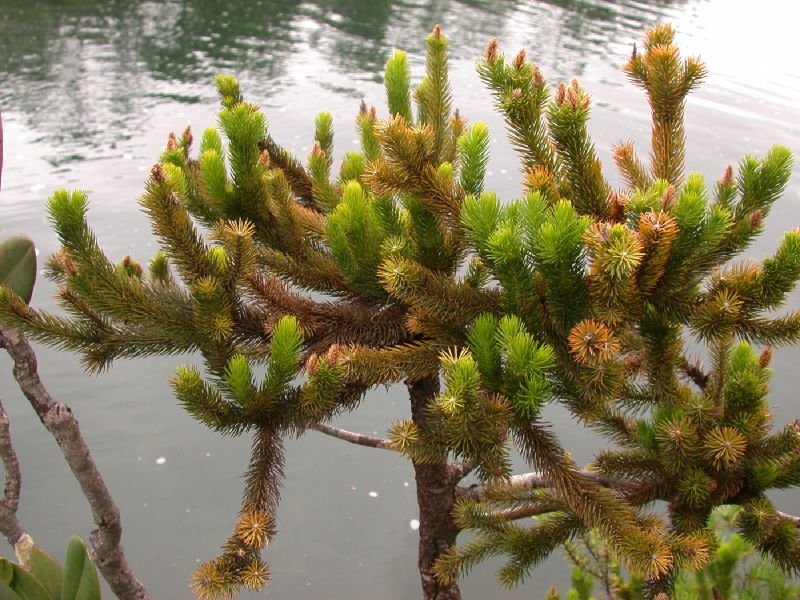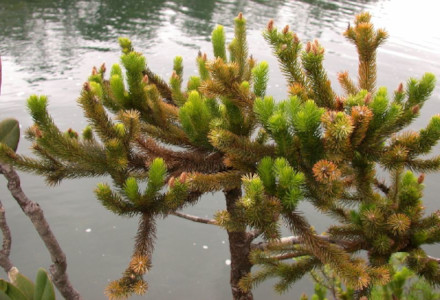
Swamp Dacrydium Facts
- The fabulous and distinctive creation of Nature most often goes by the informative common name of the Swamp Dacrydium. Yet, the flora also possesses another, though less frequently used, moniker. That’s the somewhat unusual name of the cat-tail Rimu.
- Scientific professionals, however, such as researchers, typically refer to the species by its official, technical name. That term’s somewhat hard for the layman to pronounce, though. That’s because it bears the official name of the Dacrydium guillauminii.
- The intriguing plant further received that slightly tongue-twisiting title at the hands of the respected American botanist, John Theodore Buchholz. This noted scientist made the first formal acknowledgement of it as a separate and distinct species, in 1949.
- Regardless of which term one chooses to use for it, the remarkable conifer represents a marvel of evolution. Unfortunately, however, it seems to have a very limited presence in the wild. This also appears to hold true across the entirety of its native range.
- The IUCN, therefore, lists the Swamp Dacrydium as Critically Endangered on its Red List. It faces multiple threats, including the occurrence of frequent forest fires, and human encroachment on its habitat. It’s greatest threat, though, is from climate change.
Related Articles
Swamp Dacrydium Physical Description
The wondrous Swamp Dacrydium quickly fascinates those fortunate enough to encounter it. That holds true due a variety of reasons, of course, that vary between individuals. This fascination, however, occurs wholly regardless of the physical size of the Gymnosperm.
That’s true since it does not develop strictly as a tree. Instead, though it qualifies as an evergreen, it evolved as either a variety of moderate-sized shrub, or small tree. Each specimen develops slightly differently, due to variations in its precise environmental factors.
In terms of height, this marvel of Nature only reaches a maximum known size of 7 ft (2.1 m). Most individuals, though, actually remain slightly smaller than that. It further typically manifests as an erect variety, with its many branches being densely packed together.
The bark itself garners some interest due to its specific nature. This part develops as a light brown in color, with a fibrous texture. That aspect of the species also has small, scale-like structures when young. As it ages, these features evolved into many cracks and crevices.
As with many of its relatives, the leaves of the Swamp Dacrydium appear as long and quite thin. This needle-like foliage also has an extremely sharp point. These overlap thickly, but remain rather short. Each typically attains an average length of 0.5 – 0.67 in (13 – 17 mm).
- Kingdom: Plantae
- Phylum: Tracheophytes
- Class: Pinopsida
- Order: Pinales
- Family: Podocarpaceae
- Genus: Dacrydium
- Species: D. guillauminii
Swamp Dacrydium Distribution, Habitat, and Ecology
Regrettably, the Swamp Dacrydium possesses an extremely limited zone of habitation. The region of the globe in which it evolved, however, qualifies as comparatively remote. Its location lies in a small portion of the Pacific Ocean, 750 mi (1,210 km) east of Australia.
More exactly, it evolved as endemic to Grand Terre, the main island of the archipelago of New Caledonia. Intriguingly, scientific evidence indicates that it may never have existed outside of this restricted range. This, therefore, contributed to its unique development.
Even within that enormously limited zone of habitation, it has very precise requirements for its habitat. That’s because it only develops along the banks of rivers and lakes. But even there, populations only occur sporadically along the shores of these formations.
The bodies of water it appears along only lie in the southeast part of the island. It also evolved one more characteristic that distinguishes it from many, though certainly not all, evergreens. The roots of this product of countless ages of evolution grow in the water.
Overall, the total area that the remarkable Swamp Dacrydium inhabits only equals about 5 sq mi (12 sq km). Estimates further place the number of adult specimens at fewer than 100 individuals. This fact greatly inhibits its chances of successful propogation, unfortunately.
The marvelous flora also reproduces in the same manner as others of its kind. Each separate bush or tree develops both male and female seed cones. These structures range in size from 0.3 – 0.55 in (8 – 14 mm). Within each of these, Nature places no more than 5 seeds.
Species Sharing Its Range
Check out our other articles on 5 Magnificent Mammals of Argentina, Atlantic White-Spotted Octopus, Mount Erebus, Asian Weaver Ant, Yellow Throated Marten

